Last Updated on August 14, 2023 by Robert Price
Death, taxes, and baldness. They’re three inevitable facts of life.
The stats are shocking. Some men start losing hair before they lose their virginity. And a full 66% of guys have noticeable hair loss by the age of 35.
Women aren’t immune either. 40% of all hair loss sufferers are female.
So you’re not alone, my balding brother or sister.
When we start losing our hair, we get a glimpse of our own mortality. And we have two options: accept fate or fight it.
We’re not all ripped movie stars.
“Just shave it, bro,” your juiced-up and handsome balding buddy might tell you. “Look at Jason Statham and the Rock. They look better bald than they did with hair.”
While it’s true that some men (and women) look amazing bald, it’s not a style that suits everyone. Some of us have big ears, scarring, a cone head, or all of the above like I do. Moreover, some of us would just prefer not to be bald.
Whether you’re a cone-headed mutant who has no business shaving his head ever, like me, or you’re just wondering about your hair loss treatment options, this post is for you.
As a hair loss researcher and consumer advocate, I’ve spent hundreds of hours researching this subject.
My goal is simple. I want to provide you with the best, most current, reader-friendly, and unbiased hair loss treatment guide on the internet.
That means you won’t have to click around and view a hundred different articles to find what you’re looking for. No links to schedule a free hair transplant consultation, either.
Like I said, my objective is to provide you with everything you need to know about hair loss treatment, right here, in this one post. It’s an ambitious goal, I know.
Now, before we head out onto the battlefield, let’s briefly assess the damage…
How Bald are You?
Ready, gents?
The Norwood Scale depicts the most commonly observed patterns of hair loss in men.
Approximately where do you sit on the chart below?
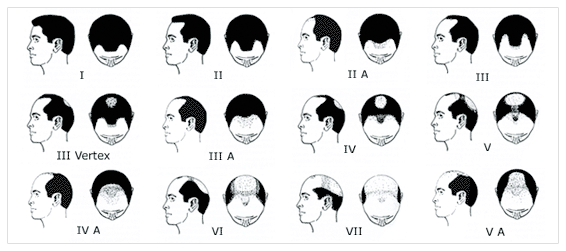
More baldness = a more challenging battle. Anything past a Norwood 3 is considered a form of baldness. Norwood 2 is something of a gray area but may be indicative of a receding hairline or worse.
For the Ladies
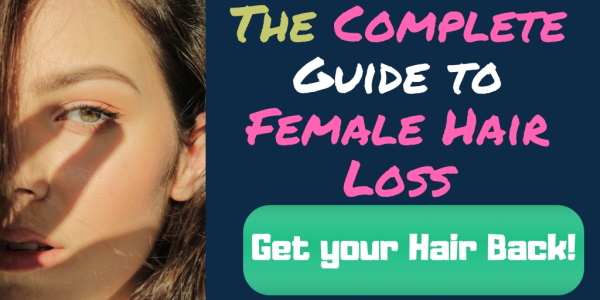
Female hair loss is complicated. While most of the treatments I list here work for men and women, my female hair loss treatment article provides more gender-specific details.
One More Quick Question
How old are you?
If you were already rocking a modified comb over in high school and you’re 20 now, you have my condolences. Because the earlier hair loss begins, the more aggressive it tends to be. So you’ll want to act fast and be proactive if your hair is important to you.
No matter what stage of hair loss you’re in, chances are you’re facing a familiar foe that’s plagued mankind for generations.
Our Enemy – DHT
Sure, there are other causes of hair loss, from stress and pregnancy to vitamin deficiencies. But let’s not kid ourselves or complicate the matter. In men, 95-plus percent of hair loss cases are related to androgenic alopecia, AKA male pattern baldness.
What causes pattern hair loss? The hormone DHT of course.
Some men’s hair follicles are impervious to DHT. David Schwimmer is an example. The dude is in his 50s and has a hairline like a chimp. But he’s in the minority group, and a full 80 percent of guys go bald to some degree.

DHT made the professor here go bald. In people with genetic hair loss, the hormone destroys or weakens healthy hair follicles over time via a process called miniaturization.
How long does it take to go bald? The stats vary. But it’s roughly a 10-25 year process for most of us—and remember, people go bald to varying degrees. The earlier you catch it, the better.
Okay, now we know what we’re up against, so it’s time to plan our battle strategy. Here are the seven most powerful ways to attack hair loss:
Weapon # 1. – Minoxidil
Old faithful. Your grandpa’s hair loss remedy, so to speak.
Minoxidil’s literally been a lifesaver for hundreds of thousands if not millions of men. I’m being facetious, but just a little bit. It was the first effective hair growth treatment produced on a mass scale.
It’s helped multiple generations of men defy nature and enjoy convertible rides into retirement, with the cool wind in their hair.

No bald spot up ahead or in the rear view for this guy!
How Minoxidil Works
While the exact mechanism is unknown, experts believe Minoxidil works by extending the hair-growth cycle and promoting blood flow to the scalp.
2012 Minoxidil Study
In a year-long study with 984 participants, 62 percent of the participants had positive results. Their balding areas were noticeably smaller by the study’s conclusion. 35.1% of the participants showed no significant hair loss or gain—in other words, they didn’t lose any ground.
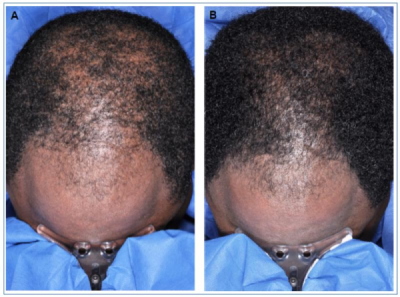
Before and after minoxidil picture. Photo from this eight-week minoxidil study.
How to Apply Minoxidil
For men, most doctors advise applying the the 5 percent solution twice daily. But many doctors also say that using the product only once per day at bedtime is sufficient.
If you just use it once per day, you should use at least twice as much product, according to Dr. Bernstein, a prominent hair restoration surgeon and the co-author of Hair Loss & Replacement for Dummies (source).
For women, doctors typically recommend either a once-daily 5 percent minoxidil regimen or a twice-daily 2 percent treatment course.
Foam vs. Liquid
As I say in my article comparing foam vs. liquid minoxidil, the choice ultimately comes down to your preference. They both work similarly. The liquid is a bit greasier. The foam can be difficult to apply to long hair and it’s more expensive. Either variety can help dramatically slow the balding process.
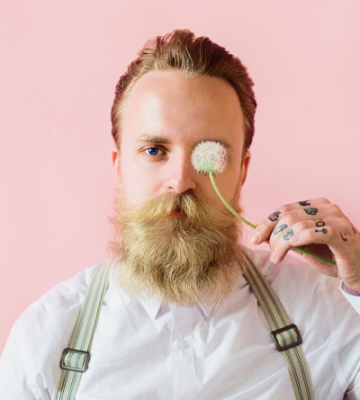
Minoxidil is also a popular beard-growth stimulant.
Side Effects
Side effects are rare. Skin irritation and unwanted facial hair growth are the two most common complaints. More serious absorptive side effects, while rare, are also possible.
Three Minoxidil Positives
1. Affordable - Minoxidil is perhaps the most budget-friendly hair loss treatment option. The popular Kirkland brand minoxidil can cost as little as $4 to $5 per month.
2. FDA approved – It is the only FDA-approved treatment for hair loss, other than Finasteride (Propecia).
3. It Works – While minoxidil is no miracle cure for balding, the research clearly indicates that it helps combat pattern hair loss in men and women.
Three Downsides
1. Hair Changes – Some people have reported changes in their hair color or texture in the areas where the treatment is applied—this is usually limited to the new hairs grown with the aid of the minoxidil (source).
2. Unpleasant After Effects – Some minoxidil products may leave a greasy or unpleasant residue after application.
3. Unlikely to Work in All Cases – Minoxidil works best for people with mild to moderate hair loss. If you have a particularly aggressive case of male pattern baldness, you’ll probably need to a stronger weapon to combat it. More on that in a minute.
My Take on Minoxidil – My dad’s using it. It’s been working for him.
I don’t like that your hair can kind of become “addicted” to minoxidil.
If you stop using it, you’ll lose it—and you may lose all your gains quite quickly. But minoxidil works for most people and it’s relatively risk free.
Popular Minoxidil Products
Note – this post contains affiliate links. That means I may earn a small commission, at no extra cost to you, if you purchase a product I list on my site. My goal is to only recommend products I’d use or recommend to a family member.
Weapon 2 – Finasteride or Propecia
Okay, don’t tense up on me now. I’m sure you’ve heard the horror stories. Maybe a certain body part of yours is going a little limp as we speak. But relax, I’m here to put your mind at ease.
This section will be longer than the rest. Why? Because Finasteride is our most potent weapon against hair loss. It’s also the most controversial one as of 2022. I’m going to review the facts only, so you can decide for yourself whether or not the treatment is worth pursuing.

Somewhere, as we speak, somebody’s blaming Propecia for ruining their life on a hair loss forum. You can almost hear them screaming, can’t you?
Here’s the deal. Contrary to what you might hear on certain websites, finasteride AKA Propecia is a generally well-tolerated medication. It’s also the only FDA-approved hair loss treatment that targets DHT and can stop balding in its tracks. Regrowth is possible too.
How it Works
Finasteride blocks the conversion of testosterone to dihydrotestosterone, the baldness hormone, in both the serum (blood) and in the areas surrounding the hair follicles. It lowers DHT levels by about 70 percent.
Dosage Recommendations
One mg daily is the FDA-approved and most common dose for hair loss. However, low-dose finasteride has become increasingly popular over the last few years. A .5 mg dose of the drug is about 80 percent as effective as a full dose. Some men go even lower. A .25 mg dose delivers roughly half the benefit.
Topical finasteride is another option. Early research indicates that topical finasteride may be just about as effective as oral finasteride, with less side effects.
Five Year Study – Works for 9 out 10 Men
In perhaps the most significant long-term finasteride study, researchers found that after five years, 90 percent of the participants who used finasteride showed show no further visible hair loss. 65 percent of the patients either improved or maintained their hair counts from baseline.
Side effects were rare. They included lack of desire for sex (1.8% vs. 1.3% in the placebo group), along with erectile dysfunction (1.3% vs. 0.7%).
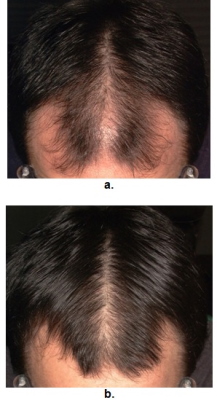
Before-and-after finasteride picture. Photo from one of the drug’s original trials.
Over the course of 10 years, Italian researchers tracked the progress of 114 Propecia users. While this wasn’t a double-blinded or placebo-controlled study, the findings are still pretty remarkable:
- 86 percent of the participants benefited from finasteride—and its effectiveness was not found to diminish significantly over time.
- Only 14 percent had additional hair loss.
- 48 percent saw improvements over time.
- 7 subjects (5.9 percent) reported side effects.
Taking 500% More Propecia Per Day is Safe too!
Don’t do that—at least not without your doctor’s blessing. But briefly, in a 7-year Prostate Cancer prevention study with over 17,000 participants, researchers found that finasteride (5 mg per day, 5 times the recommend dose for hair loss) had a minimal effect on sexual functioning in most men.
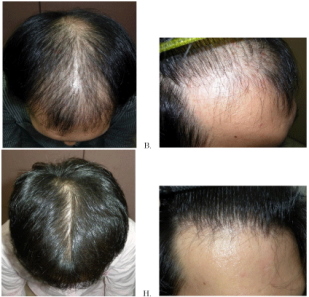
After 10 years on finasteride! Photo from this long-term, Japanese finasteride study.
Finasteride Side Effects
I’m sure you’re primarily concerned with the side effect most people associate with finasteride use: impotence.
But the odds of that happening to you are pretty remote.
In the extensive FDA trials, only 1-2 percent of users reported sexual side effects. And more importantly, once a patient stopped using the drug, their side effects went away in all cases. Finasteride users have also reported headaches, dizziness, runny noses, rashes, along with swelling of the hands, feet, and breasts. Since the initial trials, depression is also sometimes cited as a potential side effect of the drug.
Psychological Side Effects (Nocebo)
If you expect Propecia to break your penis, well, don’t be surprised if your overall performance in a certain area is affected. This phenomenon is known as the nocebo effect. If you expect the worst-case scenario, there’s a good chance that’s what you’ll get.
3 Finasteride Positives
1. Best First Line of Attack – Finasteride can dramatically slow or stop hair loss in tracks and promote regrowth in many men. It’s the only treatment that effectively addresses the mechanism that causes balding in the first place, DHT.
2. FDA approved – Finasteride is regarded as a safe and effective treatment for hair loss by the FDA.
3. Works throughout the Scalp – It typically works on both the hairline and the crown, even though results are usually a bit more favorable on the crown.
The Downsides
1. The Side Effects – While rare, the potential side effects are particularly unpleasant. There’s no getting around that fact.
2. The Unknown – It’s been FDA approved for nearly 25 years. But hypothetically it’s possible that taking a drug over the course of a lifetime—and blocking a hormone—could lead to problems down the road. The long-term side effects aren’t fully established at this point. As the first generation of men who used the drug begin to age, we’ll learn more.

Photo Credit: CNN. Fun fact: President Trump is a long-time Propecia user and advocate. His hair (most likely) looks bizarre due to outdated scalp-reduction procedures though, not the finasteride.
My Take on Finasteride
Finasteride, in spite of all the controversy, remains a viable hair loss treatment option in my opinion, especially in cases of severe hair loss, where there may be no effective alternatives available.
The side effects have been documented, and yes, they are scary. But it appears that most people can tolerate the drug, and it’s been something of a miracle for many 20-something young men.
At this time, I see no compelling evidence that indicates the side effects will continue many months or years after a patient stops using the drug, as some users have claimed on certain websites. If you begin a finasteride treatment course with an open mind, you’ll most likely be fine.
Weapon #3 – Dutasteride, The DHT Destroyer!
What if you’re among the unlucky 10% of men who don’t respond to finasteride?
Dutasteride, AKA Avodart, could be the answer. It’s a far more potent option that reduces DHT levels by about 98 percent! Remember, finasteride only reduced that number by 70 percent.
2006 Study – More Effective than Finasteride
In a 24-week study with 416 participants, researchers compared the effectiveness of finasteride vs. dutasteride. They found, not surprisingly, that dutasteride was the clear-cut winner, producing higher hair counts in the targeted areas.
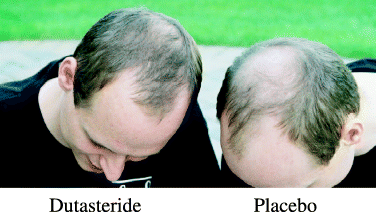
In a small study conducted on twins, dutasteride significantly slowed the progression of pattern hair loss. Results above are after 6 months of treatment.
Dutasteride is used primarily to treat BPH, an enlarged prostate. It’s not an FDA-approved hair loss medication.
However, it is sometimes prescribed “off label” by physicians, primarily hair transplant doctors. If finasteride doesn’t work with you, it’s something you could discuss with either your primary care provider, a dermatologist, or a hair loss specialist. Interestingly, dutasteride is approved to treat hair loss in both Korea and Japan.
Dosage
.5 mg is the standard dose.
Dutasteride Injections (Mesotherapy)
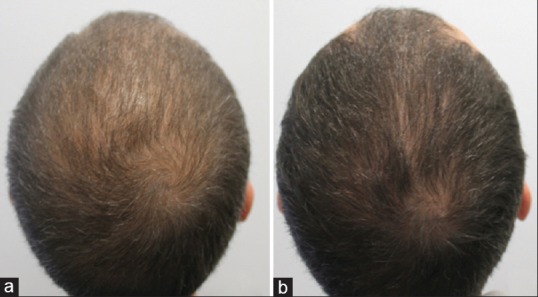
Results from a 2017 dutasteride mestotherapy (injection) study
Dutasteride injections (Mesotherapy) also show potential in the treatment of pattern hair loss. And unlike oral dutasteride, in the 2017 study listed above, researchers found that the dutasteride injections didn’t lower serum (blood) DHT levels. No adverse effects were reported either.
However, unfortunately dutasteride mesotherapy has very limited availability in 2020. Hopefully more studies will be conducted soon.
Side Effects
Even though this is a potent drug, it’s well-tolerated for the most part. Dr. William Rassman noted on his blog that sterility was a potential side effect. So that’s not optimal.
In its FDA trial, which had over four thousand participants, researchers found that sexual side effects were rare with Avodart. Early on in the study, however, 4.7 percent of users on the medication reported impotence, compared with 1.7% on the placebo. The numbers leveled out by the time the study concluded. For reference, you can view the sexual side effect chart below.
Three Positives
1. DHT Destroyer – This is a nuclear option, no doubt. If dutasteride doesn’t work for you, then you’re probably just destined to be bald. It’s perhaps the most formidable weapon against androgenic alopecia.
2. Probably safe – I mean, it can’t be guaranteed. But research indicates the drug is well-tolerated by and large.
3. A Last Resort – If all else fails, it’s good to have options. This is one of them.
Three Negatives
1. Side effects – there’s a higher chance of side effects with this treatment than any other, perhaps.
2. The Unknown – Once again. Is blocking DHT over the course of years or decades a great idea, especially for younger men? The jury’s still out.
3. Safer Options Available – It’s a high-risk (relatively) and high-reward treatment.
My Take on Dutasteride – I hate the idea of blocking DHT all together, which is effectively what dutasteride does. However, if you’re determined to keep your hair and finasteride isn’t cutting it, then I believe it’s something you might want to consider.
Weapon #4 – PRP/PRP+ACell
A new kid on the block, Platelet rich plasma (PRP) is a somewhat promising hair loss treatment option. It’s expensive. And even though some providers claim they can provide long-lasting results with PRP, it’s only proven to deliver temporary gains.

PRP is known as the “vampire” treatment for hair loss. The patient’s own blood is used for the procedure.
Dr. Jeffrey Rapaport of the Cosmetic Skin & Surgery Center in New Jersey says it is “one of the best-kept secrets in dermatology” and claims to use it effectively for hair loss. Many doctors remain skeptical.
No significant long-term studies exist to validate its efficacy. But the anecdotal evidence is compelling—compelling enough for me to keep the treatment on this list, four years after my first draft.
How PRP Works
Essentially, the patient uses their own blood platelets to promote hair growth. The platelets aid in wound healing and contain seven growth factors. The procedure starts with a blood draw, then the blood is spun in a centrifuge and applied to the scalp.
PRP Studies
In a three-month PRP study with 20 participants, researchers tested the safety and efficacy of PRP. The study had no control (placebo) group. Multiple PRP dosages were tested.
At the study’s conclusion, the team found that 1.5 million platelets per micro-liter was the ideal dose. They also stated that they believed PRP had a positive effect on pattern baldness.
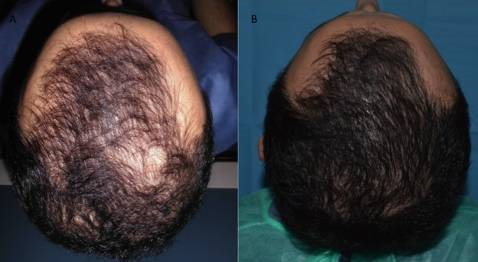
Excellent responder. 29-year-old patient at baseline then 3 months later, after three rounds of PRP.
Problems – Where to start? No control group. Countless studies show that the placebo effect is real and can even lead to hair growth in balding men. For a while, anyway. The study was also tiny in terms of its length and sample size.
Other small studies have also been conducted and shown favorable results with PRP.
Pros
1. Good Results are Possible – The anecdotal evidence is compelling, as I said, as are the small studies.
2. Side effects are minimal – In most cases, PRP side effects limited to minor pain, redness at the injection site, and pinpoint bleeding.
3. Buys Time, at the very least – This is perhaps the only procedure that can genuinely buy you some time by providing you with favorable results quickly and temporarily promoting growth.
Cons
1. Results Will Vary – The procedure is still relatively new, and there isn’t a universal treatment protocol. It’s a wild west of sorts, and many practitioners are jumping onto the PRP bandwagon as a way to boost profits. Safe to say this is a very operator-dependent treatment, so choose your doctor wisely.
2. Not Permanent – You’ll need ongoing treatments to maintain your results.
3. Expensive – The cost can vary significantly, but $400 is usually the minimum, and for (reportedly) longer-lasting PRP+ACell sessions, the fee may be as high as $6,000.
My Take: PRP could very well be a first-line treatment for male pattern baldness and female hair loss in the near future. However, it’s currently a cost-prohibitive option. The research is promising but mostly anecdotal. I believe the fact that it can, in some cases, deliver pretty remarkable results in short order make it worthy of including on my list.
Weapon # 5 – Low-Level Laser Therapy
The embarrassing treatment—but only if you get caught using it, of course. Laser helmets all have one thing in common: they look ridiculous. But as I said in my in-depth post on laser therapy, many of you would wear a potato salad on your head each night if it stopped hair loss.
Does laser therapy work?
Based on my research, a tentative yes is the answer.
How Laser Therapy Works
The exact mechanism is unknown. But researchers speculate that not unlike minoxidil, it helps stimulate the anogen or growing phase of the hair-growth cycle.
2014 Study
In a 26-week laser therapy study with 128 male and 141 female participants, researchers compared the effectiveness of the original Laser Comb vs. a sham device. The study was double-blinded and placebo controlled. Results were favorable. See the picture and chart below.

One woman’s transformation.
Sham vs. Laser Device – Changes in Hair Density. The findings from week 1 to week week 26 of the trial:
The research is limited, again. And reviews among doctors are mixed. Doctors Pak and Rassman of New Hair both state unequivocally that they do not believer lasers work.
But many hair loss specialists endorse the treatment too. Jennifer Ahdout, MD, a dermatologist in Beverly Hills, had the most sober and accurate take on the subject, in my view, stating that laser therapy was a “safe treatment with some mild proven benefit.”
Pros
1. No Major Side Effects – Side effects are very unusual with laser therapy, which sets this treatment apart from some other, more popular treatments.
2. It Can Be Combined with Other Therapies – Check with your doctor first, but in most cases, combining laser therapy with minoxidil or finasteride is perfectly acceptable.
3. Can Re-energize Your Hair – Some patients have reported excellent results with laser therapy.
Cons
1. It’s a Hassle – You’re going to need to wear a ridiculous helmet or cap, probably for at least an hour or so each week. Some of the cap are fairly stylish, granted—and it’s not like the treatment hurts.
2. Results will Vary – Again, not everyone is going to achieve their desired goals with laser therapy. But if you stick with it, use a quality product, and aren’t suffering from major hair loss yet, then there’s a good chance it can help you maintain some hair. Significant regrowth is less likely.
3. Pricey – Devices start at $200 or so and can cost up to 3,000 for medical-grade devices.
My Take: I’ve dubbed laser therapy the “why not” treatment in the past.
It definitely doesn’t work for anyone, and the research is limited.
I don’t believe it’s likely to work without some “backup” from a more established treatment such as minoxidil or finasteride. But if can afford it and you’re determined to keep your hair, it’s worth considering.
Laser Device I Like
Kiierr 272 MD Laser – Typically only available through physicians, the Kiier 272 laser can be purchased directly from their website for a limited time. An FDA-cleared product with excellent reviews, it’s backed by a generous three-year warranty as of

Click the image above or the following link to learn the 7 things you should before you buy a laser cap.
Weapon # 6 – Hair Transplantation
Donald Trump likely had his hair procedures done in these 80s. Obviously, the industry has come a long way since then!
If you find an experienced and reputable surgeon, there’s a good chance you can achieve fantastic and totally undetectable results via hair transplantation.
First, you’ll need a comprehensive exam to determine if you’re a good candidate for a hair transplant. Factors like your age, hair type, hair density, family hair loss history, degree of hair loss, scalp laxity (how well your tissues stretch when under pressure), and even your ethnicity must be assessed.
However, hair transplants aren’t for everyone, and a high percentage of patients end up needing more than one procedure to achieve their desired results. The transplanted hair is permanent in most cases. But if a patient has further hair loss in the future, additional procedures may be desired.
FUT vs. FUE
Overall, FUT (follicular unit transplantation) tends to yield more coverage. So if you have significant hair loss, or expect to have significant hair loss, FUT may be the better option.
It’s a “strip” procedure where a narrow sliver of tissue is taken from the back and sides of the scalp. Follicular units are then removed from that strip and placed into the desired areas.
A linear scar will remain after the FUT transplant; the scar typically isn’t visible unless the patient elects to cut their hair very short.
FUT is falling out of favor among practitioners and patients for a variety of reasons—profitability, recovery times, steeper learning curves for new surgeons, and more—so it may only be available via specialized clinics in the future.
FUE (Follicular Unit Excision) “harvests” donor hair via small circular incisions. Follicular units are pulled directly from the scalp. If the donor area is overharvested, the area can appear thin or have a moth-like appearance.
FUE is a less invasive procedure. It’s preferred by many patients for that reason. Other FUE advantages include:
- Shorter recovery time
- Allows for shorter hairstyles
- No linear scar
Each procedure has its place and can deliver exceptional, life-changing results. Contrary to what some doctors say, neither the FUT or FUE method is objectively “better” than the other. Each has its benefits and drawbacks.
Pros of Hair Transplantation
1. Often Undetectable – Nobody needs to know you had a hair transplant. Your own hair is used to complete the procedure, not those old-school plugs of the past.
2. Safe – Side effects are possible and some discomfort may occur after the surgery, but the procedure is considered to be extremely safe.
3. Permanent – The transplanted hairs will remain in your scalp permanently with few exceptions, but other parts of your scalp will still be susceptible to hair loss.
Cons
1. Shock Loss is Possible – A certain percentage of patients may experience shock loss, where non-transplanted hair in the area surrounding the hair transplant falls out. Usually this hair grows back, but occasionally the shock loss is permanent—this typically only happens to patients who are already experiencing significant hair loss in areas adjacent to their transplant site. The risk can be minimized with preventative treatments like finasteride, minoxidil, and laser therapy.
2. There will be a Scar – Where the hair harvested, you will have a scar across the back of your scalp. Hair transplant scars are much less noticeable than they used to be, especially with the popular FUE procedures—and they can often be diminished significantly via a post-op scar removal. Unless you buzz your head frequently, the scar is unlikely to be a major issue.
3. Expensive – Pricing will vary, but you’re probably looking at a minimum of $3,000, the average cost is closer to 10K, and yes, they can cost even more than that. And again, multiple procedures may be required to achieve optimal results, especially if you have an advanced type of balding.
My Take
Hair transplants have come a long way, there’s no doubt about it. Your transplanted hair will look, feel, and function like your real hair, because it will be your real hair, of course—just moved from the back of your scalp to your balding areas. And don’t worry, you can get by with less hair on the back of your head.
It’s a good idea to have your hair loss under control, at least to some extent, before undergoing a procedure. This will help you avoid shock loss and ensure the best possible outcome.
Bottom line: If you can afford it and you’re a good candidate for transplantation, this may be an excellent option for you. Patients in their 20s are often considered to be most susceptible to shock loss, so keep that in mind.
Weapon #7 – Ketoconazole Shampoo
Trying to fight hair loss with any shampoo alone would be like trying to fight a nuclear war with a musket. But ketoconazole is an ingredient that has been shown to slow the progression of hair loss to a degree. This is more of a supplementary treatment. And it barely made the list.
But if you use a ketoconazole shampoo in conjunction with a proven product like minoxidil or finasteride, it may be beneficial. Collectively, the three products when used simultaneously—minoxidil, finasteride, and a ketoconazole shampoo like Nizoral or Lipogaine—are sometimes known as the “Big 3” in hair loss prevention.
How It Works
While the exact mechanism is unknown, it’s believed that ketoconazole shampoo may help block androgen receptors in the scalp, thus reducing DHT levels and slowing the rate of hair loss. They may also decrease inflammation, another factor in the hair-loss puzzle.
2019 Study
Research is very limited.
But in a six-month study, a team of researchers sought to determine which was more effective, 2% minoxidil or a 2% ketoconazole shampoo.
After six months, they concluded that while minoxidil worked faster, with gains observed after only four months on average, the ketoconazole group also saw significant improvements. They ultimately labeled the contest a draw.
One Woman’s Transformation
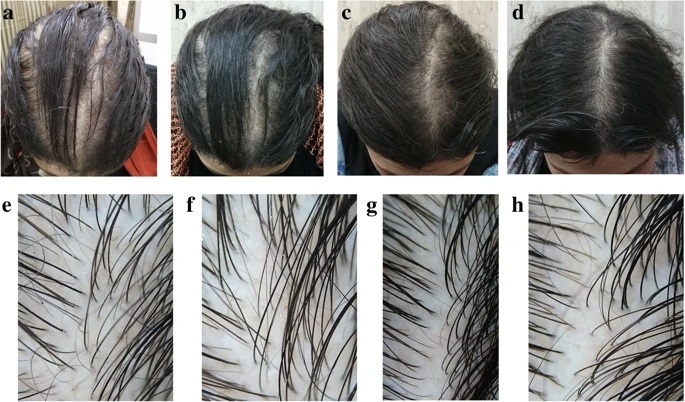
Patient satisfaction rates were similar. Her results are at baseline, then after 2, 4 and 6 months using the shampoo.
Other Ingredients that May Help
Again, the research is pretty limited. But some studies have indicated that caffeine is another ingredient that can slow hair loss. DHT-lowering supplements like saw palmetto could also, in theory, be helpful.
Ketoconazole Advantages
1. Mildly Helpful, Potentially – It’s a treatment that’s easy to include in your regimen—and one that certainly won’t hurt your cause.
2. Fairly Cheap – Nizoral is the cheapest of the products. A bottle will only set you back about $14 on Amazon.
3. Well Tolerated – While some of the products are a bit harsh, most people use them without any major complaints.
Cons
1. Like Bringing a Knife to a Gunfight – No shampoo alone is likely to combat balding effectively in the long run.
2. Many Doctors are Skeptical – While some do recommend shampoos in their practices, I think it’s safe to say that most do not.
3. Better Options Available – This is at the bottom of the list for a reason.
My Take
This option is probably best reserved for those looking to throw the proverbial kitchen sink at their hair loss. More effective solutions with more substantial track records are available.
If you’re interested, here’s a link to purchase Lipogaine Big 3 shampoo.
Other Weapons and Adjunct Therapies
Shaving your head is another powerful way to attack hair loss! It doesn’t get more alpha than that. Many people look good bald, and who knows, you could be one of them.
Modern hair systems, formerly known as toupees, are often amazing. Granted, they require some maintenance and the quality ones aren’t cheap.
Scalp micro-pigmentation—small tattoos on the scalp that match your hair color—can help disguise your thinning. Alternatively, you could use this treatment to create the illusion that you have a buzz cut rather than a mostly bald head.
Hair fiber products are also fantastic for making hair loss less visible.
The mad-scientist approach may also be viable. RU58841, the “for research only” topical solution is regarded by some as a better, safer alternative to finasteride. There’s some anecdotal evidence to suggest it works quite well but its safety profile is questionable in my opinion, which is why I left it off my list.
Determined to treat your hair loss naturally? Good luck; you’re going to need it! Just kidding, kind of. There are some natural remedies that may help treat hair loss to a limited extent, including saw palmetto, pumpkin seed oil, and rosemary oil.
Top 7 Hair Loss Treatment Options – Review
Costs are approximate, obviously. Here they are:
- Minoxidil – Cost: $5-$30 per month. Cost will depend on the product you buy and the extent of your hair loss. Must be used consistently to see continued results.
- Finasteride – Cost: About $10 per month for the generic. FDA approved for men only. Works better than minoxidil (and great with minoxidil, often times) and is the only treatment that is proven to address the underlying cause of hair loss, DHT.
- Dutasteride – Cost: about $20 per month for the generic. A DHT destroyer. Likely works better than finasteride but comes with additional risks.
- PRP – Cost: $400-$6,000 per session. Longer-lasting treatments will cost more. Results can last for anywhere from a month to a year, potentially longer. Newer procedure, with no standardized treatment protocol.
- Laser Therapy – Cost: $400-$3,000 for a cap device, $200-$300 for a comb. May help re-energize your weak or dying hair follicles. Works best for patients with mild to moderate hair loss, and can usually be combined with other therapies.
- Hair Transplantation – Cost: 5-15K. Average is around 10 grand. Again, the cost depends on your personal situation and the doctor. Can yield fantastic, undetectable results.
- Ketoconazole shampoo – Cost: $5-$50 per month. More a supplementary treatment. May help block androgens in the scalp and impede the balding process to a small extent.
Do you have any thoughts or opinions on the seven hair loss treatment options I listed?
Disagree with any item on the list? As always, I’d love to hear from you in the comment section.
Robert Price is a writer, consumer advocate, and hair loss researcher with thousands of hours of experience in the field. His goal is to keep you out of the hair loss rabbit hole, underworld, or whatever you want to call it. He founded Hair Loss Daily, the unbiased hair loss blog, in 2016. You can learn more about Robert in the my story section of this website.







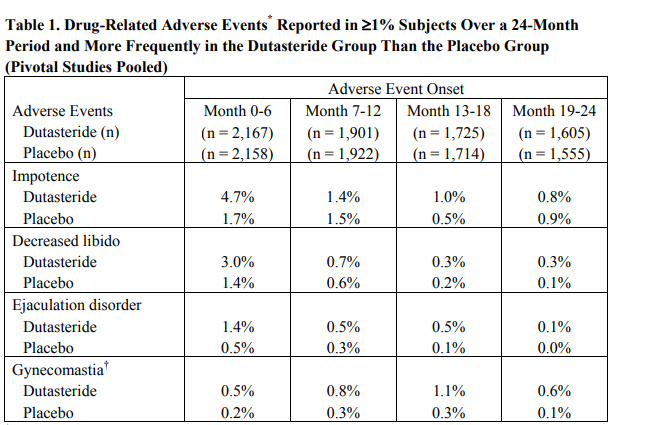









There is an 8th option to deal with hair loss…………Scalp Micropigmentation! This is a procedure that implants pigment into the scalp in a way that simulates hair follicles. It can give a guy the look of a full head of hair that has been freshly shaved. Check out ink-credible.com for before and after photos and more information about the procedure.
Micropigmentation is thousands of tiny tattoos, Right? Problem with that is it leaves just one styling option: the freshly shaved look. Boring. For me that would be follicular folly. My favorite option is the most natural therapy of all: acceptance. I chose to fully embrace male pattern baldness. It was an easy choice. Actually, it chose me. At age 5 or 6 I fell in madly in love with the prospect of going bald like my favorite uncle and my grandfather. By the time I graduated from college I was desperate to go bald, but it wasn’t destined to happen for another 30 years. When it finally happened, I simply let it my hair fall out. I had absolutely no interest in keeping my hair. And the going bald option cost me nothing, other than the expense of buying a few hats. No, I wasn’t trying to hide my MPB, I was protecting my newly bald head from sunburn in summer and the cold in winter. But best of all, I really, really enjoyed going bald.
Well said, Eric! Acceptance and embrace is the absolute best solution to hair loss. If, however, you cannot do that, Scalp Micropigmentation can remove the stigma that some men feel over their hair loss. You are right, in that this treatment is meant to simulate a freshly shaved look and there is an element of commitment involved. For some, this is the least expensive and most liberating solution.
I enjoyed reading your story!
Stigma is the problem. Why the stigma? Male pattern baldness is a natural, normal inherited trait, not a disease in search of a cure. And in most cases it look great. We need a total cultural attitude adjustment regarding MPB. After all, it’s not going away. As we grow older, more and more of us begin to lose our hair. By my age (mid 70s) most of us have lost a significant amount of our cranial hair. So we are in the majority. Misery loves company? Not me. I love male pattern baldness. Based on the small number of my male relatives who are/were bald, I had less than a 50% chance of going bald, so I lucked out. Despite the poor odds, I went bald. To my delight! In my case it wasn’t grudging acceptance, or a luke warm embrace. It was enthusiastic welcome and celebration. And my wife and I have been celebrating my MPB ever since.